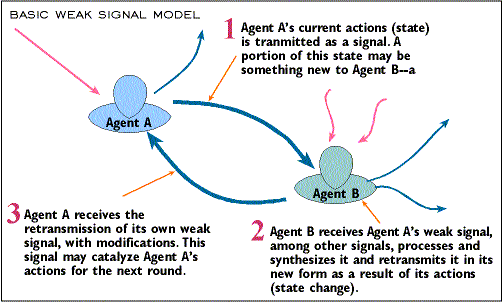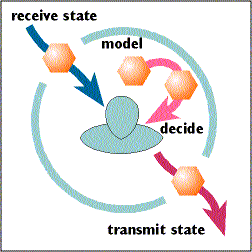|

Weak Signal® Research
Part V: A Process Model for Weak Signal Research
Bryan S. Coffman
January 21, 1997
back to Part I: Introduction
back to Part II: Information Theory
back to Part III: Sampling, Uncertainty
and Phase Shifts in Weak Signals
back to Part IV: Evolution and Growth
of the Weak Signal to Maturity
The Range of Weak Signal Research
Processes
Following is a list of some processes that might be of interest:
- How an enterprise creates weak signals
- How an enterprise hunts for and models weak signals and scenarios
of weak signal ecosystems
- How enterprises can propagate weak signals to other systems in the
environment
- How an enterprise can employ and apply weak signals to improve its
ability to thrive
- How networks or ecosystems of weak signals self-assemble across multiple
systems in the environment
- Designing and building an enterprise that can manage all of the above
without relying upon a bureaucratic or departmental approach.
MG Taylor Corporation is offering a series of Weak Signal Workshops to
be held later in 1997. The purpose of these workshops will include both
a discovery and documentation of models for these processes.
Portions of these processes have already been presented in other parts
of this paper. Miller's Living Systems model
explains the structure of the signal and information processing system.
Part III of this paper discussed sampling strategies.
The 'Spoze model handled suspension of disbelief
in the hunt for weak signals. Part IV of this paper outlined a four-step model for the
emergence and growth of a weak signal. The Appropriate
Response model illustrates some of the criteria for testing strategies
for capitalizing on weak signals.
This paper will present a rough model of these processes in an attempt
at synthesis, but the reader is encouraged to make his or her own observations
of how enterprises successfully handle weak signals, and build models
as a consequence. Certainly there are many valuable approaches and insights
that can be made. If you wish, we can post some of those models to our
website for the benefit of others. Click on the E-mail button at the bottom
of this page for the address.
Agents and Actions
In this discussion of processes I'll be referring to Agents and Actions.
An Agent can be an individual, group, team or enterprise--any entity or
collection of entities that acts in concord and presents a single identity.
Actions refer to specific behaviors that the Agent exhibits at any one
time. The Actions of one Agent may influence another Agent to modify his
behavior, and produce different Actions. A web of such mutual influences
that is stable (homeostatic) and reproduces (or grows) is capable of accomplishing
the six processes listed above.
In the terms of the science of complexity, an Action that an Agent exhibits
at some point of time is called its current state.
The breadth of all possible Actions that an Agent can exhibit is called
state space. If the Agent has settled into a
set of Actions, the cycling through which allows it to thrive, it is said
to inhabit a stable basin of attraction in state
space. As conditions in the environment change through competition or
cooperation, the Agent may have to hunt for a better, or more fit, basin
of attraction. This hunting process is called evolution or adaptation.
An Agent that is capable of such behavior is called an adaptive
agent. Autocatalysis--as it relates
to the enterprise--refers to one Agent's ability to facilitate the productivity
and creativity of another Agent. A web of such Actors who influence each
other's Actions to cause the web to coalesce, gain identity, grow, survive
and reproduce is called an autocatalytic network.
More common terms for this are enterprise, organization, company, community,
team.
Although some of these terms may seem mysterious to us because
they were born in the science of biology, their representations in our
organizations are familiar. An organization's state of being can be a
very complex thing, involving perhaps thousands of variables. Accounting
models and product advertising are two simple windows opening onto this
current state. There are life cycle models that present simplified maps
of state space from birth to death of the enterprise. MG Taylor's version
of this is called the Stages of an Enterprise model. When an organization
hits upon a "system" for doing its work profitably, and it repeats
this system reliably, then it is in a stable basin of attraction. If it
can survive assaults by competitors and other external and internal threats
and opportunities by adjusting its structure and processes, it is adaptive.
If the output of the organization exceeds or is not predicted by the potential
output of its components if they were acting separately (synergy) then
its members have an autocatalytic relationship with each other: they can
do more together than they could do apart.
All of these features are natural and every organizational
system exhibits or embodies them. The question is, will bringing these
terms into consciousness help to map the underlying processes and structures,
and can this mapping be transformed into a collaborative edge? In other
words, can self-knowledge lead to self-improvement?
Agent to Agent Process

In previous parts of this paper I've examined weak signal
from a time-based process view. This diagram shows the weak signal process
in simplified form from an entity-based process. Agents A and B both exhibit
behaviors, or states. This exhibition is a form of conscious/unconscious,
voluntary/involuntary transmission of signals: we observe the behavior
of other organizations and organisms in the world around us. Agent B does
this by employing input transducers (eyes, ears, phones, computers) to
gather signals produced by these other entities. Most signals are deflected
by Agent B for reasons discussed in Part II. Some signals get through
and are processed to help the receiver maintain its own balance, or homeostasis.
Other signals get through and may contain messages that are totally new.
If Agent B's Associator mechanism is adaptable enough, it can process
these new messages as weak signals, folding them into larger predictive
models or scenarios. Then it can use these new predictions to make decisions
that affect its own behavior, or state. Agent A may pick up on these behavioral
signals from Agent B, recognize its own weak signal as a component, and
modify its behavior accordingly. If this cycle of modification allows
the two agents (along with many others) to form a productive, profitable
web, then autocatalysis is achieved and the weak signal passes into the
stage of becoming a strong signal.
But the point is that the entire process is governed solely
by several discrete events:
- Transmission of a system state to the environment
- Reception of this system state by another system
- Association and synthesis of new weak signals into predictive models
- Decision making based on the predictive models that yields a new system
state
 That's it. We receive stuff, model the stuff we receive,
figure out what to do next, and then send that stuff... If a web of interactivity
results, and it helps us thrive, then we've helped launch a weak signal
into a full-fledged trend and we will benefit from it. That's it. We receive stuff, model the stuff we receive,
figure out what to do next, and then send that stuff... If a web of interactivity
results, and it helps us thrive, then we've helped launch a weak signal
into a full-fledged trend and we will benefit from it.
This helps us target areas for improvement in our own enterprises. We
can scrutinize and modify how we receive signals and what we are willing
to receive. Recall from Part II that this is termed "knowing our
noise." We can examine our modeling process--our ability to play
'Spoze and the robustness of the resulting models. We can examine the
modeling process for its incorporation of nonlinear, or lateral thinking.
We can understand how that modeling process folds into our decision-making
and what criteria we use for allowing strategies to pass the decision
threshold--what our definition is for Appropriate Response. Then we can
take a look at how we transmit what we've learned to the environment in
a form and manner that makes it most useful. If it's useful, then other
organizations will pick it up and it will be amplified as it's passed
on.
Another Version of the WSR Process Model
Below is another version of the same process
using different terminology which may be more useful to some readers.
Steps 2-5 constitute what goes on in the system's Associator. For the
interest of MG Taylor network members, the Scan Focus Act model is mapped
onto the process model.

-
Perceive new issue (a message with meaning) in the environment
-
Establish a hypothesis concerning the future of the
issue
-
Formulate questions to validate or invalidate the hypothesis
-
Map (model) the landscape of the issue, hunt for and
select related signals based on the questions
-
Determine consequences of the map or model and design
the opportunity
-
Decide
-
Implement
Other material on Weak Signal Research on this website
 
copyright © 1997, MG Taylor Corporation.
All rights reserved
copyrights,
terms and conditions
19970121220342.web.bsc
|

